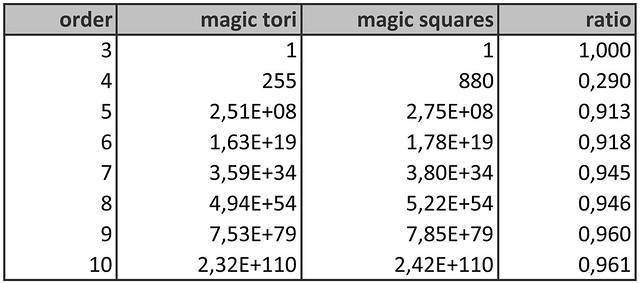Walter Trump has kindly authorised me to publish his results concerning 6th and higher-order magic tori. When studying the fourth-order magic tori it had been anticipated that there might be some semi-magic tori with crossed magic diagonals producing no magic intersections (and thus displaying no magic squares). However, after computer calculation, the 4th-order semi-magic tori were all found to have either parallel magic diagonals or no magic diagonals at all. So, it was quite interesting to discover that cases of semi-magic squares with crossed magic diagonals do exist in 6th-order tori, as shown in the following example:
Until now, for even-order magic tori, I have always considered an intersection of magic diagonals to be a magic intersection when it could coincide with the centre of a magic square. In the case of even-order tori, magic intersections therefore take place between numbers, and never over numbers. However, on even-order magic tori, an intersection of magic diagonals that occurs over numbers is not to be overlooked. It may be sterile as far as magic squares are concerned, but it may also be just as significant as a classic magic intersection.
It should be remembered that semi-magic squares can have close magic square cousins on a same torus (as on the partially pandiagonal 4th-order tori type T4.03). The fact that certain squares displayed on these tori appear to be just semi-magic is a false impression. Like their magic square cousins they only offer partial views of the magic tori that they belong to.
It should be remembered that semi-magic squares can have close magic square cousins on a same torus (as on the partially pandiagonal 4th-order tori type T4.03). The fact that certain squares displayed on these tori appear to be just semi-magic is a false impression. Like their magic square cousins they only offer partial views of the magic tori that they belong to.
The torus concept opens new perspectives for semi-magic squares which until today tended to be neglected. Semi-magic squares are now to be recognised as being as important as their magic square cousins. In the table that follows Walter Trump counts all tori with crossed diagonals as being magic tori, even if some of these do not display traditional magic squares. The cases of tori having only "sterile" intersections of crossed magic diagonals begins with 6th and higher-order tori. The number of magic tori that has already been identified for 3rd, 4th and 5th-orders therefore remains unchanged:
The numbers are written in Excel form. 3,59E+34 means 3,59 x 1034
There is an ongoing debate as to the validity of the order 1 magic square, and Walter Trump has chosen to exclude the order 1 from the above table. Depending on individual preference, the magic square sequence A006052 of the On-Line Encyclopedia of Integer Sequences (1, 0, 1, 880, 275305224... with offset 1), could also be presented as 1, 880, 275305224 ... with offset 3.




No comments:
Post a Comment
Or, should you prefer to send a private message, please email william.walkington@wandoo.fr